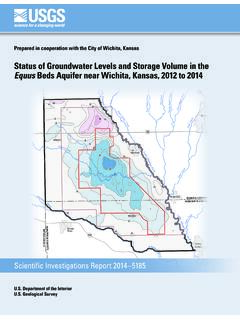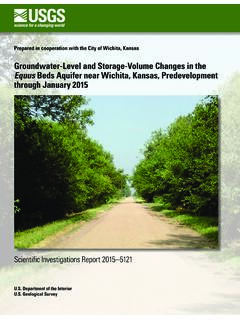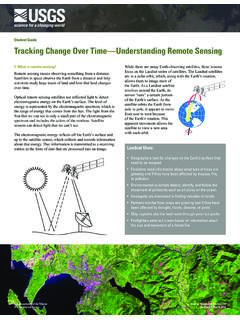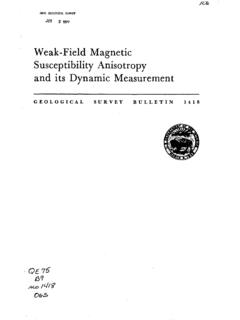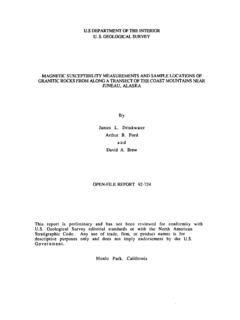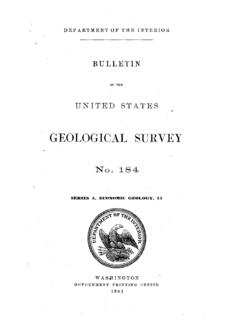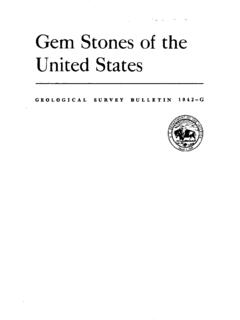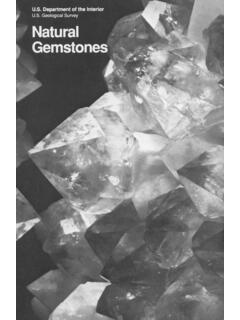Transcription of Mineral-Deposit Model for Lithium-Cesium-Tantalum ... - USGS
1 Mineral-Deposit Model for Lithium-Cesium- Tantalum Pegmatites Chapter O of Mineral Deposit Models for Resource Assessment Scientific Investigations Report 2010 5070 O. Department of the Interior Geological Survey Cover. Giant crystals of beryl from the Bumpus pegmatite mine in Maine. The vintage 1927 photograph is from Perham (1986), used with permission. Mineral-Deposit Model for Lithium-Cesium- Tantalum Pegmatites By Dwight C. Bradley, Andrew D. McCauley, and Lisa M. Stillings Chapter O of Mineral Deposit Models for Resource Assessment Scientific Investigations Report 2010 5070 O. Department of the Interior Geological Survey Department of the Interior SALLY JEWELL, Secretary Geological Survey Suzette M. Kimball, Director Geological Survey, Reston, Virginia: 2017. For more information on the USGS the Federal source for science about the Earth, its natural and living resources, natural hazards, and the environment visit or call 1 888 ASK USGS.
2 For an overview of USGS information products, including maps, imagery, and publications, visit Any use of trade, firm, or product names is for descriptive purposes only and does not imply endorsement by the Government. Although this information product, for the most part, is in the public domain, it also may contain copyrighted materials as noted in the text. Permission to reproduce copyrighted items must be secured from the copyright owner. Suggested citation: Bradley, , McCauley, , and Stillings, , 2017, Mineral-Deposit Model for Lithium-Cesium-Tantalum pegmatites: Geological Survey Scientific Investigations Report 2010 5070 O, 48 p., ISSN 2328-0328 (online). iii Contents Deposit Type and Associated Nomenclature and Brief Associated Deposit Primary and By-Product Trace Example Deposits ..12. History of Pegmatite Regional Tectonic Temporal (Secular) Duration of Magmatic System and (or) Mineralizing Relation to Relations to Igneous Relations to Sedimentary Relations to Metamorphic Physical Description of Dimensions, Form, and Host Geophysical Hypogene Ore Mineralogy and Mineral Zoning Textures, Structure, and Grain Hypogene Gangue Mineralogy and Mineral Hydrothermal Supergene Ore and Gangue Geochemical Trace Elements and Element Fluid Inclusion and Melt Inclusion Thermometry and Stable Isotope Petrology of Associated Igneous LCT Pegmatite Environment of Theory of Pegmatite Ore Deposit System Sources of Sources of Melt Chemical Transport and Nature of Geological Traps that Trigger Ore iv Geological Exploration and Assessment Regional-Scale District-Scale Alteration Geophysical Geoenvironmental Features and Anthropogenic Mining Soil and Sediment Signatures Prior to Drainage Signatures from Mining of LCT Climate Effects on Geoenvironmental Mining Methods.
3 33. Ore-Processing Methods ..33. Metal Mobility from Solid Mine Knowledge Gaps and Future Research References Appendix. Grade-Tonnage Data and Figures 1. Photographs of 2. World map showing the locations of noteworthy pegmatites and related granites categorized by 3. Graph showing aluminum silicate phase diagram showing pegmatite 4. Pegmatite classes from C ern and Ercit (2005) as clarified by 5. Schematic cross section showing schematic cross section through Appenines and Tyrrhenian Sea in the Late Miocene, at about 7 Ma (million years before present) showing simultaneous foreland thrusting and hinterland extension, and location of the Elba pegmatites when they were 6. Age distributions covering most of Earth history, back to 4000 million years before present (Ma). A, Probability plot of crystallization ages of igneous rocks. B, Histogram of detrital zircon ages from Pleistocene and modern sediments, using unfiltered data from the global dataset of Voice and others (2011).
4 C, Histogram of ages of Lithium-Cesium-Tantalum (LCT) pegmatites, updated from the global compilation of McCauley and Bradley (2014)..16. 7. Map of the Wodgina district, Western Australia, showing fault control, from Sweetapple and Collins (2002)..17. 8. Cross section through the Tanco pegmatite, Manitoba, Canada, showing zoning, from Stilling and others (2006)..19. 9. Cross section through the Altai No. 3 pegmatite, Inner Mongolia, China, from Zhu and others (2006)..20. 10. Cross section through the giant Greenbushes pegmatite, Australia, from Partington and others (1995)..21. 11. Phase diagram for lithium silicates under conditions of quartz saturation, from London (1992)..22. 12. Map showing idealized concentric, regional zoning pattern in a pegmatite field, adapted from Galeschuk and Vanstone (2005) after Trueman and C ern (1982)..23. v 13. Map of the Ghost Lake pegmatite field, Ontario, Canada, showing regional zoning, from Breaks and Moore (1992).
5 24. 14. Deposit-scale zoning patterns in an idealized pegmatite, modified from Fetherston (2004) after C ern (1991a)..25. 15. Graph showing garnet compositions in pegmatites as a function of degree of fractionation, from Selway and others (2005)..25. 16. Graph showing trace element abundances relative to upper continental crust, Little Nahanni pegmatite group, Canada, based on data from Barnes and others (2012)..27. 17. Maps showing lithium and rubidium geochemical anomalies over the buried Tanco pegmatite, Manitoba, Canada, adapted from Trueman and C ern (1982)..31. 18. Graph showing paleolatitude plotted against time for selected northern Appalachian Appendix Figures A1. Graph showing grade-tonnage plot for lithium in Lithium-Cesium-Tantalum (LCT). pegmatites, based on data in table A2. Graph showing grade-tonnage plot for tantalum in Lithium-Cesium-Tantalum (LCT). pegmatites, based on data in table Tables 1. Noteworthy Lithium-Cesium-Tantalum (LCT) pegmatites of the 2.
6 Common lithium-, cesium-, and tantalum-bearing minerals in lithium-cesium- tantalum (LCT) Appendix Tables A1. Grade-tonnage data for lithium in Lithium-Cesium-Tantalum (LCT) A2. Grade-tonnage data for tantalum in Lithium-Cesium-Tantalum (LCT) Mineral-Deposit Model for Lithium-Cesium- Tantalum Pegmatites By Dwight C. Bradley, Andrew D. McCauley, and Lisa M. Stillings Abstract diffusion. This, in turn, enables pegmatites to form thin dikes and massive crystals despite having a felsic composition and Lithium-Cesium-Tantalum (LCT) pegmatites comprise temperatures that are significantly lower than ordinary granitic a compositionally defined subset of granitic pegmatites. The melts. Lithium-Cesium-Tantalum pegmatites crystallized at major minerals are quartz, potassium feldspar, albite, and remarkably low temperatures (about 350 550 C) in a remark- muscovite; typical accessory minerals include biotite, garnet, ably short time (days to years).
7 Tourmaline, and apatite. The principal lithium ore minerals Lithium-Cesium-Tantalum pegmatites form in orogenic are spodumene, petalite, and lepidolite; cesium mostly comes hinterlands as products of plate convergence. Most formed from pollucite; and tantalum mostly comes from columbite- during collisional orogeny (for example, Kings Mountain tantalite. Tin ore as cassiterite and beryllium ore as beryl also district, North Carolina). Specific causes of LCT pegmatite- occur in LCT pegmatites, as do a number of gemstones and related magmatism could include: ordinary arc processes; over high-value museum specimens of rare minerals. Individual thickening of continental crust during collision or subduc- crystals in LCT pegmatites can be enormous: the largest spod- tion; slab breakoff during or after collision; slab delamina- umene was 14 meters long, the largest beryl was 18 meters tion before, during, or after collision; and late collisional long, and the largest potassium feldspar was 49 meters long.
8 Extensional collapse and consequent decompression melting. Lithium-Cesium-Tantalum pegmatites account for about Lithium-Cesium-Tantalum pegmatite deposits are present in all one-fourth of the world's lithium production, most of the continents including Antarctica and in rocks spanning 3 billion tantalum production, and all of the cesium production. Giant years of Earth history. The global age distribution of LCT. deposits include Tanco in Canada, Greenbushes in Australia, pegmatites is similar to those of common pegmatites, orogenic and Bikita in Zimbabwe. The largest lithium pegmatite in granites, and detrital zircons. Peak times of LCT pegmatite the United States, at King's Mountain, North Carolina, is no genesis at about 2640, 1800, 960, 485, and 310 Ma (million longer being mined although large reserves of lithium remain. years before present) correspond to times of collisional orog- Depending on size and attitude of the pegmatite, a variety eny and supercontinent assembly.
9 Between these pulses were of mining techniques are used, including artisanal surface long intervals when few or no LCT pegmatites formed. These mining, open-pit surface mining, small underground work- minima overlap with supercontinent tenures at ca. 2450 2225, ings, and large underground operations using room-and-pillar 1625 1000, 875 725, and 250 200 Ma. design. In favorable circumstances, what would otherwise Exploration and assessment for LCT pegmatites are guided be gangue minerals (quartz, potassium feldspar, albite, and by a number of observations. In frontier areas where explora- muscovite) can be mined along with lithium and (or) tantalum tion has been minimal at best, the key first-order criteria are an as coproducts. orogenic hinterland setting, appropriate regional metamorphic Most LCT pegmatites are hosted in metamorphosed grades, and the presence of evolved granites and common supracrustal rocks in the upper greenschist to lower amphibo- granitic pegmatites.
10 New LCT pegmatites are most likely to be lite facies. Lithium-Cesium-Tantalum pegmatite intrusions found near known deposits. Pegmatites tend to show a regional generally are emplaced late during orogeny, with emplacement mineralogical and geochemical zoning pattern with respect to being controlled by pre-existing structures. Typically, they the inferred parental granite, with the greatest enrichment in the crop out near evolved, peraluminous granites and leucogran- more distal pegmatites. Mineral-chemical trends in common ites from which they are inferred to be derived by fractional pegmatites that can point toward an evolved LCT pegmatite crystallization. In cases where a parental granite pluton is include: increasing rubidium in potassium feldspar, increas- not exposed, one is inferred to lie at depth. Lithium-cesium- ing lithium in white mica, increasing manganese in garnet, tantalum LCT pegmatite melts are enriched in fluxing com- and increasing tantalum and manganese in columbite-tantalite.

